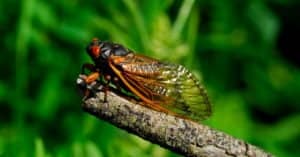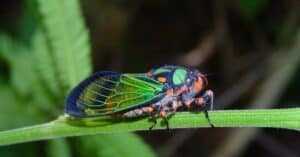Have you seen a really big bee outside? We’re talking really, REALLY big – a scary-looking wasp that is 2 inches in length.
You may be wondering, did I just see a murder hornet? Should I kill it? Should I call the authorities? Am I in danger? Here, we’ll examine how budding entomologists in North America can tell the difference between the native cicada killer wasp and the possibly invasive Japanese hornet.
Cicada Killer vs Japanese Hornet
Eastern cicada killers (Sphecius speciosus) and Japanese hornets (Vespa mandarinia) don’t normally occupy the same continent, but sightings of Japanese “murder hornets” in the U.S. have sparked many misidentifications of the cicada killer, a large and harmless native wasp.
Since these insects are about the same size, how can you tell them apart? Consider where you sighted it, the coloration, and the stinger.
Comparing Cicada Killer vs Japanese Hornet
Consider the following differences between cicada killers and Japanese hornets.
| Cicada Killer | Japanese Hornet | |
|---|---|---|
| Geographic Location | The United States, concentrated in the east | Asia, Russia, and North America’s Pacific Northwest |
| Coloration | Darker with fewer yellow bands | Yellow head, yellow and brown-banded abdomen – Long, sharp stinger; aggressive |
| Stinger | Black, blunt stinger; non-aggressive | Long, sharp stinger; aggressive |
The 3 Key Differences Between Cicada Killer vs Japanese Hornet
If you happen to see a two-inch-long bee, take note of these three features in order to identify it.
Geographic Location
The Japanese hornet and cicada killer wasp have geographically distant native habitats. The Japanese or Asian giant hornet inhabits much of Asia, as far north as Russia. If you see a large wasp there, it is almost certainly the Japanese hornet, the largest hornet in the world.
The eastern cicada killer, the largest and most well-known cicada killer species, lives in North America. Its range is concentrated on the eastern two-thirds of the continent, especially the east coast. If you spy a very large hornet in North America, it is almost certainly an eastern cicada killer.
Appearance
Next, you can look at the overall color of the wasp. The abdomen is the most distinctive. Cicada killers have black abdomens with three interrupted bands of yellow, while Japanese hornets have many unbroken, alternating bands of brown and orange-yellow.
Next, look at the head. Japanese hornets have an orange or yellow head, while cicada killers have a dull brown head with a small yellow patch on the face.
Finally, look at the thorax. Japanese hornets have a dark brown to a black thorax, while cicada killers have a lighter brown to an orange thorax.
Stinger
Japanese giant hornets are known for their painful sting. They have a long, sharp stinger visible at the tip of the abdomen.
Cicada killers do have a stinger, but it appears blunt by contrast. The tip of the abdomen is black and rounded.
Sting behavior can also indicate the species. If you receive a painful sting from a 2-inch-long wasp, you’ve probably encountered a murder hornet. Murder hornets inject a large amount of venom into their victims, which could prove fatal in humans, though this is a rare occurrence. They can also bite!
Male cicada killers can’t sting, and females are non-aggressive and will only sting if severely threatened.
Up Next…
- Wasps Predators: What Eats Wasps? Want to eliminate wasps from your presence? Find out wasp predators.
- 10 Incredible Asian Giant Hornet Facts Murder hornets are frightening with their 2 inch stingers and large size. Find out more about this nightmare of a hornet!
- What Do Hornets Eat? 11 Foods for This Bug Hornets are formidable hunters. Find out what they eat here.
The photo featured at the top of this post is ©
FAQs (Frequently Asked Questions)
What Is the Difference Between a Cicada Killer vs. a Japanese Hornet?
Cicada killers are large, non-aggressive ground wasps native to North America. They have an easily recognizable three-banded coloration and seldom sting. Their favorite food is the cicada, which they sting to paralyze.
Japanese hornets are native to Asia, with a few individuals sighted in North America. These large hornets attack honey bee colonies and are famous for their painful, sometimes deadly, stings.
What Can Kill a Japanese Hornet?
Many things can kill a Japanese hornet, including insecticide or crushing the insect. Interestingly, honey bees also have a strategy for eliminating this predator from their midst. If a Japanese hornet enters a honey bee hive, the smaller bees swarm around it, vibrating their wings. This raises the body temperature of each bee until the center of the cluster reaches 122 degrees Fahrenheit. This extreme temperature kills the hornet.
Can Cicada Killer Wasps Kill Humans?
Generally, no, cicada killers do not kill humans. While they have a stinger, they are not aggressive and will not sting unless crushed. However, those with known allergies to bee or wasp venom should exercise caution.
Can Japanese Hornets Kill Humans?
Yes, these large wasps kill as many as 50 people per year in Japan. They have a long stinger that can puncture a protective beekeeping suit. Victims describe the sting as feeling like hot metal. Those with allergies to bee venom are especially at risk.
Are Cicada Killer Wasps Aggressive?
No, cicada killers are not aggressive compared to other bees and wasps. They lack the nest-guarding instinct that often results in honey bees or hornet stings when humans wander too close.
Are Cicada Killers and Japanese Hornets the Same Thing as a Murder Hornet?
The Japanese hornet is also called the Japanese giant hornet, Asian giant hornet, or murder hornet. It is not the same species as the cicada killer.
Who Would Win, a Cicada Killer or Murder Hornet?
While a conflict between these species is unlikely, the Japanese hornet has a slight size advantage. Both insects are equipped with enough venom to paralyze the other – unless one is a stingless cicada killer male.
Thank you for reading! Have some feedback for us? Contact the AZ Animals editorial team.






